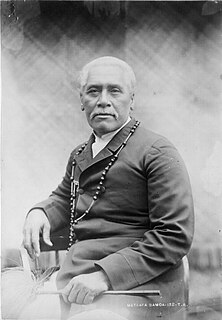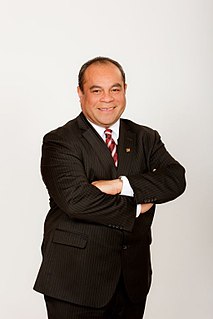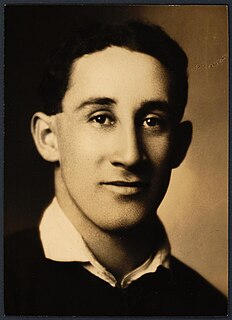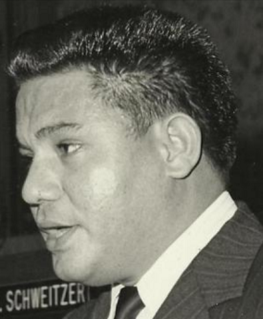 W
WGatoloaifaana Amataga Alesana-Gidlow is a Samoan politician, matai and former Cabinet Minister. She was appointed to her ministerial portfolio by Prime Minister Tuilaepa Aiono Sailele Malielegaoi following the March 2006 General elections where she was elected for the first time. Her electoral constituency is Fa'asaleleaga No. 1, part of the larger Fa'asaleleaga political district at the east end of Savai'i island. She was replaced as Minister of Health after the 2011 election.
 W
WPaul Alan Cox is an American ethnobotanist whose scientific research focuses on discovering new medicines by studying patterns of wellness and illness among indigenous peoples. Cox was born in Salt Lake City in 1953.
 W
WTui Ātua Tupua Tamasese Tupuola Tufuga Efi , is a Samoan political leader and as holder of the maximal lineage Tama-a-'āiga title of Tupua Tamasese, is one of the four paramount chiefs of Samoa. He also holds the royal pāpā title of Tui Atua.
 W
WTauaanae Tufuga Fatuatia was a Western Samoan chief and politician. He served as a member of the Legislative Assembly from 1954 until 1964, and as Minister for Health from 1961 to 1964.
 W
WTaito Phillip Hans Field is a Samoan New Zealand politician. He was a Member of Parliament (MP) for South Auckland electorates from 1993 to 2008. Field was a minister outside Cabinet in a Labour-led government from 2003 to 2005. Following charges of bribery and perverting the course of justice, he was defeated in the 2008 New Zealand general election. He was found guilty on some of the charges in August 2009 and was sentenced to six years jail in October 2009.
 W
WFonoti Matautia Ioane (John) Brown was a Western Samoan chief, businessman and politician. He was a member of the Legislative Assembly in two spells between 1948 and 1957, and held the portfolios of Agriculture and Health.
 W
WMark James Gosche is a New Zealand politician. He is a member of the Labour Party. He was born in Auckland to Samoan parents, and has been active in New Zealand's Pacific Islander community.
 W
WThe O le Ao o le Malo is the Head of State of Samoa. The position is described in Part III of the 1960 Samoan constitution. At the time the constitution was adopted, it was anticipated that future heads of state would be chosen from among the four Tama a 'Aiga "imperial" paramount chiefs. However, this is not required by the constitution, so, for this reason, Samoa can be considered a republic rather than a constitutional monarchy. The government Press Secretariat describes Head of State as a "ceremonial president". The holder is given the title of Highness, as are the heads of the four paramount chiefly dynasties.
 W
WMata'afa Iosefo was a Paramount Chief of Samoa who was one of the three rival candidates for the kingship of Samoa during colonialism. He was also referred to as Tupua Malietoa To'oa Mata'afa Iosefo. He was crowned the King of Samoa on the 15th of November 1898.
 W
WLuamanuvao Dame Winifred Alexandra Laban is a former New Zealand politician. She served as the Member of Parliament (MP) for the Mana electorate, representing the Labour Party, and was the Labour Party's spokesperson for Pacific Island Affairs and for interfaith dialogue. Laban is the Assistant Vice-Chancellor (Pasifika) at Te Herenga Waka—Victoria University of Wellington and is a respected leader in the local Pasifika community.
 W
WAiono Fanaafi Le Tagaloa was a chief (matai), scholar, historian and professor of Samoa. An authority on Samoan culture and language, she was one of the most educated female matai in the country with a PhD in educational philosophy and applied linguistics from the University of London.
 W
WTui Atua Tupua Tamasese Lealofi IV was the second Prime Minister of Samoa from 25 February 1970 to 20 March 1973 and again from 21 May 1975 to 24 March 1976. He held the title of Tupua Tamasese, one of the four main chiefly titles of Samoa from 1965 until his death in 1983.
 W
WTupua Tamasese Lealofi-o-ā'ana III was a paramount chief of Samoa, who became the leader of the country's pro-independence Mau movement during the early 1900s until his death in 1929. Inspired by his Christian beliefs, traditional customs and culture of Samoa, Lealofi III became one of the first leaders of the 20th century to employ nonviolent resistance against colonial rule which laid the foundations for Samoa's successful campaign and independence in 1962.
 W
WTuilaepa Aiono Sailele Malielegaoi is a Samoan politician who has served as the Prime Minister of Samoa and Leader of the Human Rights Protection Party since 1998, and is Samoa’s longest serving head of government. Tuilaepa first entered parliament in 1981 when he won a by election to represent the electorate of Lepa. He also served as Deputy Prime Minister and Minister of Finance in the government of former Prime Minister Tofilau Eti Alesana, and in addition also held the portfolios of Tourism and Trade, Commerce & Industry.
 W
WLauaki Namulau'ulu Mamoe was a renowned orator chief and the first leader of the Mau, a resistance movement in Samoa during colonialism. Mamoe was exiled to Saipan in 1909. He died in 1915 as he was taken back to Samoa.
 W
WMatā'afa is one of the four paramount tama-a-'aiga titles of Samoa. It is one of two such titles originating from the Atua district at the east end of Upolu island and has its historical seat in the village of Amaile. Prominent holders of the title include Matā'afa Iosefo of Falefa,one of the three rival candidates for the kingship of Samoa during the early colonial period, Matā'afa Faumuina Fiame Mulinu'u I of Lepea and Lotofaga, who became leader of Samoa's pro-independence Mau movement after Tupua Tamasese Lealofi III's assassination; and his son Fiame Matā'afa Faumuina Mulinu'u II (1921–1975), the first Prime Minister of Samoa.
 W
WFiame Naomi Mata'afa is a Samoan politician and high chieftess (matai). She was Samoa's first female Cabinet Minister, and from 2016 to 2020 served as Samoa’s first female Deputy Prime Minister. She is the daughter of Fiame Mata'afa Faumuina Mulinu’u II, Samoa's former Prime Minister. She is a former member of the Human Rights Protection Party.
 W
WMasiofo La'ulu Fetauimalemau Mata'afa, also known as Fetaui Mata'afa, was an ambassador and a member of parliament in Samoa. She was also the wife of Samoa's first Prime Minister, Fiame Mata'afa Faumuina Mulinu'u II. Their daughter, Fiame Naomi Mata'afa, is a matai high chieftess and former Cabinet Minister and former Deputy Prime Minister. The honorific title "Masiofo" is the queenly title for the wife of a paramount chief in Samoa.
 W
WFiame Mata'afa Faumuina Mulinu'u II was a Western Samoan paramount chief and politician. The holder of the Mata'afa title, one of the four main Samoan chieftainships, he became the first Prime Minister of Western Samoa in 1959, serving until 1970. He held the position again from 1973 until his death in 1975.
 W
WMata'afa Faumuina Fiame Mulinu'u I was a high chief of Samoa and a leader of the country's pro-independence Mau movement during the early 1900s. He was the holder of high-ranking ali'i chiefly titles: the Tama-a-'aiga Mata'afa, Fiame from Lotofaga and Faumuina from Lepea.
 W
WMata'afa Lealaisalanoa Muliufi was a Western Samoan high chief and politician. He held the Tama-a-Aiga title of Mata'afa from 1915 until his death.
 W
WNafanua was an historical ali'i (chief/queen) and toa (warrior) of Samoa from the Sā Tonumaipe'ā clan, who took four pāpā (district) titles, the leading ali'i titles of Samoa. After her death she became a goddess in Polynesian religion.
 W
WTa'isi Olaf Frederick Nelson was a Samoan businessman and politician. He was one of the founding leaders of the anti-colonial Mau movement.
 W
WSu'a Sulu'ape Paulo II was a tufuga ta tatau born in Matafa'a near Lefaga, Samoa but based in New Zealand since the 1970s. He was born and into one of the leading families of tattooists tufuga ta tatau in Samoa. The tattooists in these families, are loosely organized in a guild like system of master and apprentices. In the late 20th and early 21st centuries tufuga ta tatau were known internationally for their culturally distinctive and highly skilled work. The word tattoo is believed to have originated from the word tatau. In Samoan mythology the origin of the tatau is told in a legend about two sisters, Tilafaiga and Taema who brought the tools and knowledge of tattooing to Samoa. The Samoan male tattoo (tatau) is the pe'a. The female tatau is the malu.
 W
WFuiono Senio was a chief and environmentalist from Falealupo village on the island of Savai'i in Western Samoa.
 W
WAupito Tofae Su'a William Sio is a politician who became a member of the New Zealand House of Representatives on 1 April 2008 for the Labour Party as a list MP. Since the 2008 election, he has represented the Māngere electorate.
 W
WDave Solomon was a Fijian-born rugby football player who represented New Zealand in both rugby union and rugby league. His brother Frank Solomon was also an All Black.
 W
WTuimalealiifano Va'aleto'a Eti Sualauvi II is a Samoan politician who is the current O le Ao o le Malo of Samoa, in office since 2017. He was appointed to the Tama-a-'aiga title of Tuimalealiifano in July 1977, one of four paramount titles of Samoa.
 W
WTuatagaloa Tofa Siaosi was a Western Samoan politician. He served as a member of the Legislative Assembly from 1967 until 1973 and was Minister of Finance between 1970 and 1973.
 W
WTupua is a state dynasty and one of the four paramount chiefly titles of Samoa, known as the Tama-a-Aiga. It is the titular head of one of Samoa's two royal families - Sā Tupua. Tupua derives its name from the first Tupua - King Tupua Fuiavailili, a direct descendant of Queen Salamasina, Samoa's first monarch under the Tafa'ifā system. He ascended to becoming King of Samoa in c.1550, upon the death of his adoptive father, King Muagututi'a. Tupua Fuiavailili was adopted by his aunt, Fenunu'ivao and named as the King's successor. Tupua's rise also led to the first usage of the term "Tama-a-'aiga" by the orator polity of Leulumoega and Lufilufi, in reference to his many genealogical connections to the great families of Ātua.